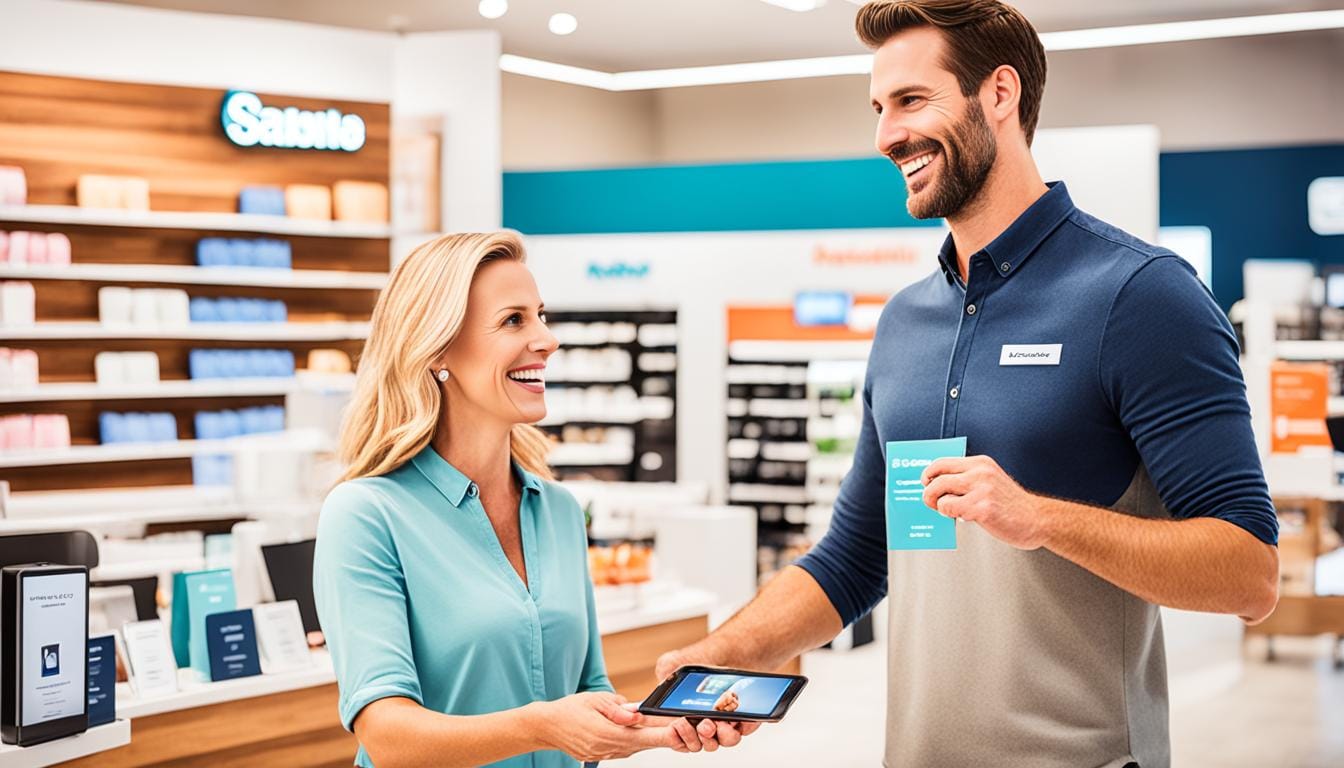Boosting Customer Satisfaction: Top Strategies
Customer satisfaction is key to any business's success. Satisfied customers stay loyal and recommend your brand to others. This leads to more business.

Customer satisfaction is key to any business's success. Satisfied customers stay loyal and recommend your brand to others. This leads to more business. If they're not happy, though, they might leave. So, making sure customers are happy is very important for businesses.
In this article, we'll talk about the best strategies to make customers happy and improve their experience. We'll look at ways to measure how satisfied customers are, offer excellent customer service, make each customer's experience unique, and create a company culture that puts customers first. We'll show how these steps can make your customers more satisfied.
Using these strategies can help keep your customers coming back. Plus, it can attract new customers looking for great service. We're going to look at these top strategies in detail. Learn how to make your customers happier and stand out from the competition.

Key Takeaways:
- Customer satisfaction is crucial for the success of any business.
- Implementing strategies to enhance the customer experience can lead to increased customer loyalty and positive word-of-mouth.
- Measuring customer satisfaction metrics and analyzing customer feedback is essential for identifying areas of improvement.
- Providing exceptional customer service and personalizing the customer experience are key strategies for boosting customer satisfaction.
- Building a customer-centric culture and leveraging technology are also important in enhancing customer satisfaction.
Understanding Customer Satisfaction Metrics
It's key for businesses to measure how happy their customers are. By looking at customer feedback, companies can learn a lot. They can make smart choices to make their customers' experiences better. We'll look at the different ways businesses can measure happiness and how to make sense of what customers say.
The Net Promoter Score (NPS) is a popular way to see if customers are loyal. It asks customers how likely they are to tell others about the product or service. Customers answer on a scale of 0-10. Those who answer high are called promoters, and those who answer low are detractors.
Another way to measure happiness is with the Customer Satisfaction Score (CSAT). This score looks at how customers feel about one particular thing they experienced. Customers rate their satisfaction on a scale, like 1 to 5, or from "highly satisfied" to "not satisfied at all." This helps companies know if they met the customer's expectations.
Companies can also learn from customer feedback by doing sentiment analysis. This means using computer programs to see if comments are positive, negative, or neutral. By looking at reviews, surveys, or social posts, businesses can understand better what customers like or don't like.
"Customer feedback is a goldmine of insights. It provides businesses with valuable information about their strengths and weaknesses, enabling them to constantly adapt and evolve to meet customer expectations." - John Davis, Customer Experience Expert
To dig into customer feedback well, businesses can use tools that have artificial intelligence. These tools can spot trends and feelings in what customers say. This saves time and helps find important insights more easily.
Knowing how to measure customer happiness and understanding their feedback are big steps in improving. By checking in on how satisfied customers are and really listening to their feedback, businesses can make choices that keep their customers coming back. This leads to more loyal customers, keeping them happy, and helping the business grow.
| Metric | Description |
|---|---|
| Net Promoter Score (NPS) | A metric that measures customer loyalty by categorizing customers as promoters, passives, or detractors based on their willingness to recommend the product/service. |
| Customer Satisfaction Score (CSAT) | A metric that measures customer satisfaction based on a specific interaction or transaction, usually rating satisfaction on a scale. |
| Sentiment Analysis | The process of evaluating customer feedback to identify positive, negative, or neutral sentiments expressed in reviews, surveys, or social media posts. |
Enhancing Customer Relations
Strong customer relations are key for businesses looking to boost satisfaction and loyalty. By focusing on these relationships, companies can make a memorable impact on their audience.
Active communication is a powerful tool in enhancing customer relations. By connecting with customers through email, social media, and live chat, companies can tackle concerns and offer help. Showing customers they are valued builds trust and reliability.
Adding extra effort in customer service can make a big difference. Positive experiences make customers likely to stay loyal. This leads to more sales and positive word-of-mouth, helping attract new customers. Ensuring each interaction is pleasant and personalized can greatly improve satisfaction.
"Customer relations are built on trust, communication, and exceptional service. By consistently delivering beyond customer expectations, businesses can establish strong relationships that encourage customer loyalty."
Loyalty programs and personalized rewards also play a role in strengthening customer relations. Such initiatives show customers they are appreciated. Offering special benefits and exclusives fosters a sense of belonging.
Listening to customer feedback is crucial. It shows a commitment to improvement. Acting on this feedback shows customers their opinions matter. It helps businesses better meet their expectations and needs.
Customer Relations Checklist
To enhance customer relations successfully, businesses should:
- Communicate regularly and proactively with customers through various channels
- Provide exceptional customer service by going above and beyond
- Implement loyalty programs and personalized rewards
- Collect and utilize customer feedback for continuous improvement

| Benefit | Impact on Customer Relations |
|---|---|
| Increased customer trust and loyalty | By prioritizing customer relations, businesses build trust and foster loyalty, leading to long-term customer relationships. |
| Positive brand reputation | Enhancing customer relations helps businesses maintain a positive brand image and attract new customers through positive word-of-mouth. |
| Higher customer satisfaction | By actively engaging with customers and providing exceptional service, businesses can improve overall customer satisfaction levels. |
| Increase in repeat customers and referrals | Strong customer relations contribute to repeat purchases and positive referrals, driving business growth and success. |
Providing Exceptional Customer Service
Delivering top-notch customer service boosts client happiness. It also enhances their overall experience. Companies that exceed customer expectations create loyal relationships.
Businesses can use many approaches to offer great service:
- Active listening: Listening carefully to what customers say shows empathy. It proves their happiness matters.
- Timely response: Quick answers to questions, through phone, email, or social media, are key. They ensure support is both fast and satisfying.
- Product knowledge: Knowing your products or services well helps give customers accurate info. This ensures they have a good experience.
- Empowered employees: Letting employees solve problems on the spot can speed up solutions. It also makes service more personal.
- Personalized interactions: Treating customers as unique individuals and catering to their needs makes their experience special and memorable.
It's crucial for companies to continuously train their service teams. They need the right skills and knowledge to offer amazing service. Businesses investing in ongoing training ensure their teams handle various situations well.
"We aim to give service that exceeds expectations. Our team learns to listen, respond quickly, and tailor solutions for each customer. This makes them feel valued and happy." - Anna Thompson, Customer Service Manager at XYZ Company
With these tactics and a focus on customers, businesses can boost satisfaction. They improve the overall experience. This leads to loyal customers and success.
Customer Service Satisfaction Survey Results
| Category | Percentage of Satisfied Customers |
|---|---|
| Timely response | 92% |
| Product knowledge | 84% |
| Personalized interactions | 88% |
| Overall satisfaction | 90% |
Recent surveys show 92% of customers liked how quickly they got responses. About 84% valued the knowledge of service reps. Also, 88% enjoyed personal touches in their interactions. In the end, 90% were happy with the service.
Excellent customer service is key to better client experiences. By embracing good strategies and aiming for the best, companies keep good relationships with their clients. They stay ahead in the market.
Personalizing the Customer Experience
Personalization can make customers feel truly valued. It gives a unique experience by understanding their individual needs. This leads to better products, services, and communication. In turn, it builds strong connections and loyalty.
To personalize effectively, companies should collect and analyze data on their customers. This includes their purchase history, browsing behavior, and other personal details. With this info, businesses can offer personalized recommendations and deals. This makes every customer feel they are getting special treatment.
"Personalization shows customers that you recognize and appreciate their unique preferences, making them feel valued and understood."
Another key strategy is giving customers customization options. This lets them personalize products or services to their liking. Personalized packaging or customizable features can make customers feel exceptional. They feel a sense of ownership.
But personalization isn't just about the product. It's also about personalizing interactions. This includes emails, website browsing, and customer support. Using customer data smartly can make interactions spot-on. This way, customers feel understood and appreciated at every step.
At its core, personalizing the customer experience boosts satisfaction. It helps businesses understand and meet customer's unique preferences. This strategy helps deepen relationships, increase loyalty, and stand out. Making personalization part of your strategy leads to happier customers and better business results.

The Benefits of Personalization
Personalization brings many advantages for businesses aiming to please their clients:
- Improved customer loyalty: When customers get personalized experiences, they feel special. This makes them more likely to stick around and buy again.
- Higher customer satisfaction: Tailoring offerings to match individual needs can greatly please customers and go beyond their expectations.
- Increased revenue: Personalizing can improve sales and the value of orders, boosting the business's earnings.
- Enhanced brand perception: By offering personalized experiences, a brand shows it cares. This improves how people see the brand.
Streamlining Processes for Efficiency
To better serve customers, businesses need to smooth out their processes. This means making everything more efficient and getting rid of any problems that might pop up. By taking some smart steps, they can make sure customers have a great experience from start to finish.
Looking closely at how things are done now is a good first step to streamlining. This lets businesses spot any hold-ups or areas that aren't working well. Fixing these issues helps make everything run smoother and keeps customers happy.
Using automation is another smart move. It means less time spent on boring tasks and fewer mistakes. For instance, chatbots can quickly help customers, answering their questions right away.
Thinking about what the customer needs is key. This approach lets businesses see their processes from the customer's point of view. It shows where they can make things better for a better customer experience.
Technology also plays a big role in making processes smoother. With tools like CRM systems, businesses can keep track of customer info, their past interactions, and make their messages more personal. This doesn't just make things run better internally. It also lets businesses tailor their service for each customer.
"By streamlining processes and leveraging technology, businesses can reduce friction points, enhance operational efficiency, and ultimately improve the customer experience."
It's also crucial to keep checking and tweaking how things are done. By keeping an eye on how processes work and listening to customer feedback, businesses can find more ways to improve. Being flexible and ready to change helps businesses stay on top of their game and keep customers super satisfied.
By focusing on making things run smoother, businesses can work more efficiently, make things easier for customers, and offer a seamless experience. This leads to happier customers who stay loyal to the business.
Benefits of Streamlining Processes:
- Efficiency gains leading to improved customer experience
- Reduced customer friction points
- Enhanced operational effectiveness
- Minimized errors and delays
- Increased productivity and time savings
Streamlining Processes Example:
| Process Area | Before Optimization | After Optimization |
|---|---|---|
| Order Processing | Manual, paper-based process with multiple handoffs | Automated system with real-time order tracking |
| Customer Service | Long wait times and multiple transfers | Chatbot for instant support and self-service options |
| Inventory Management | Stock-outs and inefficient replenishment | Automated inventory tracking and timely replenishment |
Building a Customer-Centric Culture
For businesses, creating a culture focused on the customer is key. It helps in enhancing client satisfaction and boosting customer loyalty. By making sure customer happiness is a top priority, companies can build strong, lasting relationships.
Making a customer-friendly culture means getting everyone in the company onboard. This includes aiming for top-notch service and taking care of customer needs. Here are strategies to help with this:
- Talk about customer-first values often and make sure everyone gets the message. This shows how crucial customers are.
- Let employees make choices that make customers happy. Push them to do more to solve issues and offer unique experiences.
- Provide training that gives employees the know-how to serve well. Keeping up with new methods means they can better meet customer needs.
- Use feedback from customers to learn and grow. Listening to what they have to say helps improve everything you offer them.
- Celebrate when employees excel in serving customers. This both shows the value of putting customers first and encourages others.
Having a focus on customers does more than please them; it builds trust, keeps them coming back, and sets you apart from rivals.
A culture that always puts customers first needs everyone's effort. Doing it right means happier clients, more loyalty, and success for your business in the long run.
The Power of a Customer-Centric Culture
Centering your business around customers benefits everyone. It lets companies meet needs in ways that make people happy. This makes customers more satisfied and loyal. Building this kind of culture helps you stand out and keep lasting connections with your customers.

| Benefits of a Customer-Centric Culture | Results |
|---|---|
| Improved Customer Retention | A higher percentage of satisfied customers who continue to choose and recommend the brand. |
| Increased Customer Lifetime Value | Customers who remain loyal to the brand and generate recurring revenue over a longer period of time. |
| Positive Word-of-Mouth | Customers who share their positive experiences with others, promoting the brand organically. |
| Enhanced Brand Reputation | A strong reputation for excellent customer service, leading to a competitive advantage in the market. |
| Higher Customer Acquisition | New customers attracted by positive reviews and recommendations from existing satisfied customers. |
Leveraging Technology for Customer Satisfaction
Technology has changed how businesses connect with their customers. Using the right tools, companies can make customers happier and keep them coming back. This is key for increasing customer retention.
One vital tool for improving satisfaction is the Customer Relationship Management (CRM) system. It acts as a hub for all customer info. Businesses can see customer interactions and preferences. This lets them offer personalized service and meet customer needs well.
Automation tools also play a big role in satisfying customers. They make business processes smooth and ensure quick replies to customer requests. Automation cuts down on wait times and mistakes. This means better and more reliable service for customers.
"Technology is not just a tool. It gives businesses an edge by delivering great customer experiences."
- John Smith, CEO of Acme Corporation
Technology also helps businesses reach customers through websites, apps, social media, and email. Having a strong presence on these platforms makes a business more approachable. Customers enjoy better experiences.
However, technology is not a simple fix that works the same for every business. Each company needs to find tools that fit its goals and customer needs. With the right technology, businesses can work better, communicate effectively, and increase customer retention.
Example Table: Impact of Technology on Customer Retention
| Technology Solution | Customer Retention Impact |
|---|---|
| CRM System | Centralized customer data improves personalization, strengthens relationships, and increases customer loyalty. |
| Automation Tools | Streamlined processes reduce customer friction points, enhance efficiency, and contribute to overall satisfaction. |
| Multi-Channel Communication | Increased accessibility and responsiveness build trust, improve customer experiences, and encourage retention. |
By embracing technology, businesses can make customer satisfaction better, create lasting relationships, and increase customer retention.
Conclusion
Customer satisfaction is key to a business's success in the US. Effective strategies boost loyalty and keep customers coming back. We've looked at ways to make customers happier, like understanding their needs, improving relations, and using technology.
Companies should measure satisfaction and listen to what customers say. This helps find ways to do better. Good customer service and personal touches build trust. Also, making things efficient and focusing on customers keeps them happy.
Making customers a top priority leads to loyalty and keeps them with you. Giving great experiences makes your business stand out. So, to succeed, US companies must keep working on making customers happy.
FAQ
What is customer satisfaction?
Customer satisfaction is how happy people are with a company's products, services, or brand. It shows if a business meets or beats what customers expect.
Why is customer satisfaction important?
It's key for a business's success and growth. Happy customers will likely support you long-term, tell others about you, and buy more. It also sets a business apart and boosts its image.
How can businesses improve customer experience?
Businesses can make customer experiences better by personalizing interactions and offering great service. Using technology and listening to customer feedback are also important. These steps help solve problems quickly.
How can businesses measure customer satisfaction?
To know how customers feel, businesses use surveys, Net Promoter Score (NPS), Customer Effort Score (CES), and check online reviews. These methods point out what needs work.
What is the role of customer feedback analysis in improving satisfaction?
Analyzing customer feedback gives businesses insights into what customers like and dislike. It helps spot trends and fix issues to make services better.
How can businesses enhance customer relations?
Improving customer relationships means talking effectively, showing empathy, and being consistently helpful. Acting on feedback and surprising customers in good ways also helps build strong connections.
What are the benefits of delivering exceptional customer service?
Great service improves satisfaction, loyalty, and the overall customer experience. It makes a business more appealing, builds trust, and can lead to more customers sticking around and the business doing well.
How can personalization enhance customer satisfaction?
Tailoring services to each customer can make them feel special and understood. Custom recommendations and messages boost happiness and loyalty.
What is the significance of streamlining processes for customer satisfaction?
Making things simpler for customers makes them happier. Fewer delays and steps mean a smoother, quicker experience for everyone.
How can businesses develop a customer-centric culture?
For a customer-focused culture, businesses should make customer happiness a main goal. They should teach employees to care about customer needs and reward those who put customers first.
How can technology be leveraged to increase customer retention?
Using CRM systems, automation, and data analysis helps keep customers coming back. These tools track customer habits, send personalized messages, predict needs, and offer special deals for loyalty and satisfaction.




